The Fleet Solid Support Ships programme for the Royal Fleet Auxiliary has successfully completed the Preliminary Design Review (PDR), which marks the first major milestone in the programme.
The PDR has been completed in working sessions between the Ministry of Defence (MOD), Navantia UK as prime contractor of the programme and BMT, who has led the functional design phase.
According to the firm:
“This milestone has confirmed the robustness and maturity of the design, marking the progression of the programme. The FSS now enters a new phase, focused on detailed design and heading towards the start of construction in 2025, according to the schedule.
The completion of the PDR has been possible thanks to close collaboration between Defence Equipment and Support (DE&S), Navantia UK and British designer BMT. As prime contractor, Navantia UK has overseen the design phase, contributing its programme management expertise in order to ensure the seamless integration of all facets, such as scheduling, procurement, and production engineering.”
An MOD spokesperson said:
“We are delighted to see completion of this important milestone on schedule. We would like to acknowledge Navantia UK and BMT’s strong commitment to delivering an innovative and capable design, as well as their collaboration with DE&S. The Fleet Solid Support programme is on track to deliver highly capable ships for the Royal Fleet Auxiliary and we look forward to the continued successful delivery as we work towards production milestones in 2025.”
José Luis Viguera, Navantia UK FSS Programme Liaison, said:
“Industrial collaboration is at the core of the mission of Navantia UK. Shipbuilding is a complex industry that requires the combination of the expertise of leading companies. The achievement of this significant milestone underscore Navantia UK’s excellence in programme management, showcasing our ability to lead and innovate within the industry.”
Catriona Savage, Programme Director at BMT, said “The successful completion of the PDR is a testament to the collaborative efforts within the partnership, driving the FSS programme forward. This milestone paves the way for delivering advanced and efficient support ships for the Royal Fleet Auxiliary, enhancing the Royal Navy’s operational readiness for global missions and contributing to the UK’s industrial and economic growth. Our collaboration and shared commitment to innovation are setting the stage for a new era in UK maritime capabilities.”
Following the completion of the functional design, BMT will continue to be involved in the FSS programme by monitoring changes that impact the functional design, developing through-life support and training packages, delivering comprehensive safety and environmental case reports, and supporting Navantia UK with the ships’ security accreditation.


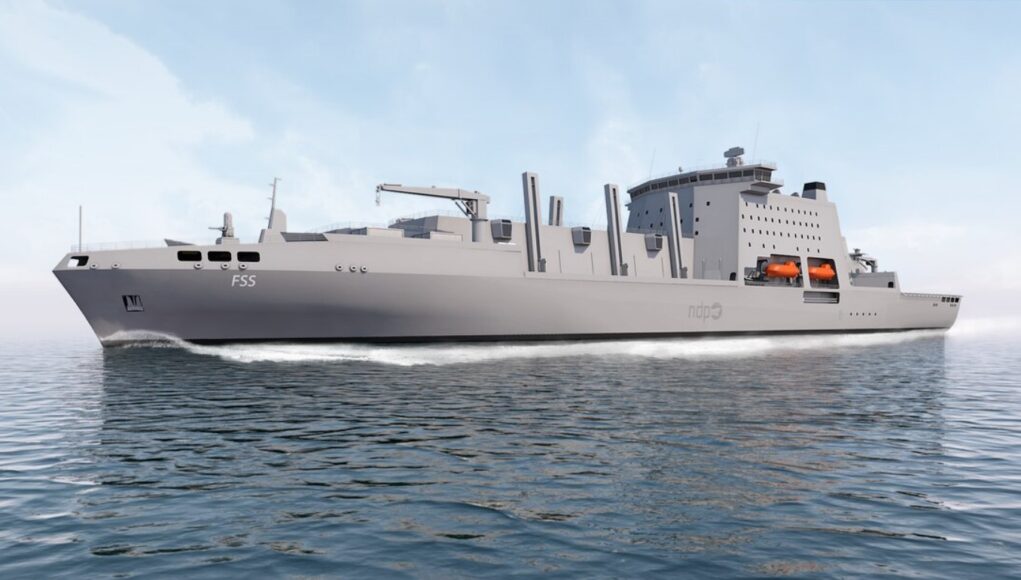
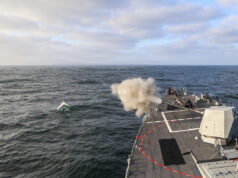
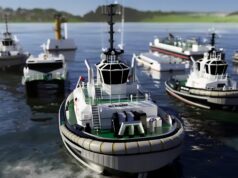
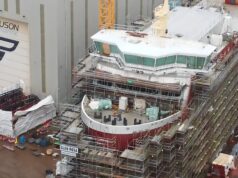
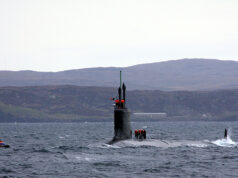
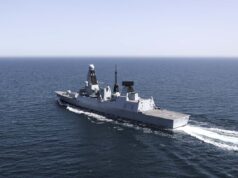

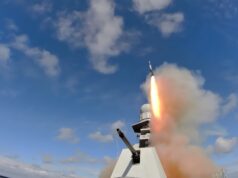
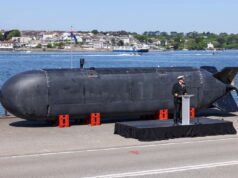
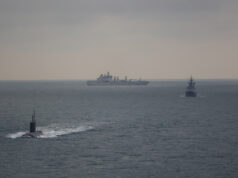
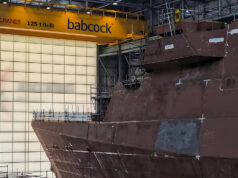

Good to see an image from Navantia. I hope we’ll be getting a bit more of a sneak preview than that.
Outdated photo unfortunately, no HRAS or dual replenishment for carriers. But I’ll be happy if the ships are crewed at this point
A disintigrating RFA and a bankrupt shipbuilder are challenges to be overcome. It may be that this design will become a historic “look at what you could have won”, but Navatia/BMT needs to be pitching again to avoid out-of-touch politicians starting a do-over.
HRAS was cut from the requirement to save money. Carrier replenishment is one side only for the same reason.
A bit pathetic though, developed a HRAS system just not tuse it for marginal savings.
They are not having HRAS anymore – 6T too complicated and restrictive in SS6 . Rigs are 2.5T
As long as it passes the industrial capability review we should be set then.
Looks like they’ll need a fair sized crew for something that large. Wonder where they are going to get them from 🤔
If the lifeboats are any indication perhaps a smaller crew.
Unless they sort out the issues at Harland &Wolff Belfast soon there will be a massive delay in building them
I hate the idea of Navantia buying the H&W site at Belfast, simple reason is it’s 100% Spanish state owned and IMHO that’s just plain nuts. The building dock, Cranes, SBOH and the Belfast dock were originally funded by HMG via grants and are a strategic asset.
As I have said before my preferred option would be to for HMG to take it back into state ownership, invest in the infrastructure and facilities and use it to build the larger ships in our building programme.
One thing is for sure State owned and run Ship building has an appalling history in UK and should never be repeated.
Australia and the US quite happily operate the GOCO system, Government Owned Contractor Operated works well in fact both BAe and Navantia have experience of running these sites in Australia and the US.
Failing that I’d swallow my trepidation, accept it sold to Navantia, hold their feet to the contact re timescales and price and just get the damned ships built. And meanwhile sit down and sort out the RFA issues.
Agree that the Spanish state via Navantia owing all of the infrastructure the UK state has helped H&W to set up would be far from ideal.
If the UK Gov wasn’t run purely by bean counters looking at spreadsheets in The Treasury then a sensible option would be to nationalise it ourselves to get FSS up and running and get H&W to a place where it can be privatised again.
Maybe the gov retains a stake (they’ve owned a chunk of RBS/Natwest for 15 years now) or as you say we retain public ownership of the site but H&W (or BAE / Babcock if the former really can’t become profitable) operate from it.
Plenty of interesting options!
The US own a lot of their industrial facilities and use the GOCO model, where it comes in really handy is when they suddenly need to expand capacity. Rather than a private company having to find a site, raise the capital etc, the Government funds the capital investment and owns it. BAe is one of the contractors they use.
On the other hand, contractors tend to be lowest-bidders and bean counters as well. Look at how our (US) nuclear sub production is suffering because they can’t even hire enough tradesmen.
How does that not end up as Ferguson Marine part 2? Who in the British government has any expertise in running a ship yard?
The innovations the military concoct with A.I. in the event of a global conflict will make all we know of military logistics, tactics and after the inevitable disastrous learning curve, strategy, will be be on the scale of difference as Agincourt is to Falaise.
Unless of course we invent a specific target EMP gun. The use of EMP bombs won’t end well.
Make peace you idiots. ☮️
You go ask the Russians to make peace then, well wait.
Amazing ain’t it🙄 the Orcs are destroying everything they can and supposedly it’s US who have to make peace!
You don’t have to make peace with the Americans, they’re on our side.
😂😅🤣 thanks for that. Made me laugh
I never argue with stupidity as it drags you down to its level and beats you with experience.
Bit hard with no crews to man the new ships. We can’t man what we got now!! Everyone is leaving due to the pay and conditions!!
Big mistake these ships classes. RN has no navy size neither crew to have solid store mission separated from replenishment.
It will make RN more vulnerable.
We already have tankers, replacing them with a multi role class now would be a waste. Plus the navy still has the ambition of being credible and globally deployabme which requires dedicated support vessels
Sell those and make these FRSSS,
There will be probably no crew available for even half of these ships.
Lol bit late for that. Seeing as the article is about another design stage being finished.
“on schedule” or as we say in the U.K. ten years late…😏
never late ….we just change the ‘schedule’
👍🙂
I would like to see the MoD/RN exploring reloading VLS at see. I think this is being looked at by the USN.
Desperately needed, we have had to borrow a tanker from Norway as we have no RFAs and our solid support ship is stuck in Portland.. We would last about 3 days in a war.
We have used allies support vessels for years. As other nations use RFA vessels for supply. It’s been that way for decades. That’s why we exercise so much with allies.
I’m beginning to wonder if the RN/RFA made a huge mistake by separating the fuel and stores replenishment roles as the 4 x Tide-class (£550 Mn) and 3 x FSS ships (£1.6+ Bn).
The two Fort Victoria AOR’s, which combined both roles, were horrendously large, expensive and required a huge crew (originally 250!) – not least because they were armed (fitted for but not with Sea Wolf VLS) and were de-facto helicopter carriers as well – able to operate 4 x Merlin’s in the ASW and VERTREP roles. However other navies have demonstrated that a more economic solution is possible.
In 2019 the French Navy has settled on building four dual-purpose “force supply vessels” (bâtiment ravitailleur de force – BRF), which in turn are based on the based upon the Italian Navy’s Vulcano-class LSS. The contract value for the four BRF’s is Euro 1.7 Bn (c. £1.4 Bn). They are individually more versatile, cost less in total, and (critically) require less personnel to crew than the RN/RFA’s prospective seven replenishment ships.
Of course, it is still far from clear that the FSS’s will actually be built given that the MOD can probably cancel the contract with Navantia for no cost at the moment. The Treasury is probably arguing that if the at-sea stores replenishment role can be gapped for 10+ years (2022-2031) then it really isn’t needed at all.
Should’ve made AORs but the RFA crisis only really reared its head after the tides.
We need FSSS though
We need the FSS ships because the Tide’s can’t carry any significant amounts of solid stores and ammunition. Up to c.2010 the RN was perhaps still large enough to justify the higher efficiency of supply ships with dedicated solid or liquid roles. That is surely no longer the case. I would prefer that the FSSS design was following the BRF/LSS multi-role philosophy. Two Tide’s could then be sold, with the remaining two saved for large exercises, FOST duty tanker and CSG deployments.
The Fort Victoria’s were an aberration – a hybrid warship and auxiliary. They were expected to act as the combined flagship, ASW helo maintenance & support base, and supply ship for escort groups protecting high value convoy’s bringing reinforcements and supplies from the USA to Europe across the North Atlantic. The original expectation was to build at least 6, but the ending of the Cold War put paid to that plan.
Definitely too late to design AORs now, wouldn’t be able to justify or afford a complete Redesign of the FSSS
What if thy will be “parked” with only 1 operational…
That is my point that i wrote above too.